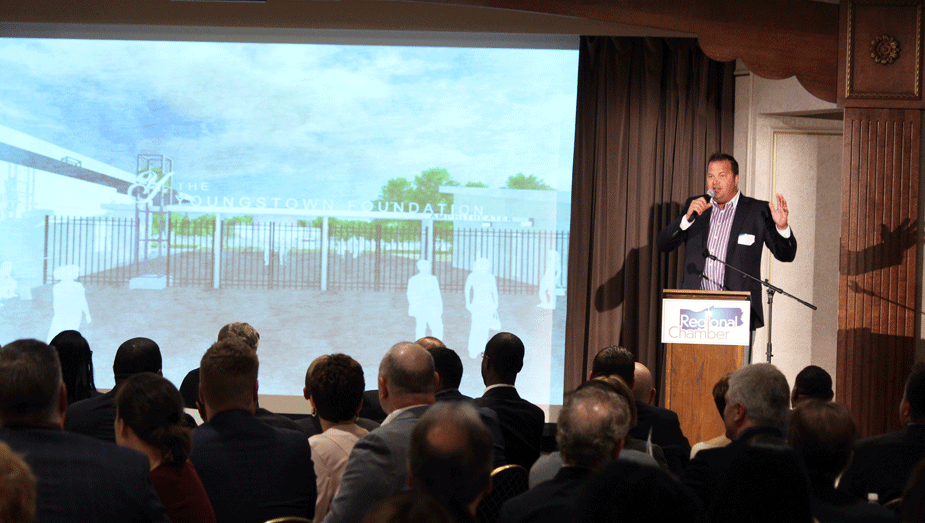Amphitheater Construction to Begin June 1
YOUNGSTOWN, Ohio – What started out as a project to provide a venue for small and inexpensive events has evolved into a new “front door” to the city, said Eric Ryan, president of JAC Management and JAC Live, this morning.
Construction of the Youngstown Foundation Amphitheater in the riverfront park will begin June 1, Ryan told guests this morning at Stambaugh Auditorium as part of the Youngstown/Warren Regional Chamber’s Good Morning, Youngstown! Breakfast.
Construction of the amphitheater will take six months, Ryan said. The amphitheater and park are slated to open next year.
Other speakers at the breakfast were Mayor Jamael Tito Brown, Eastgate Regional Council of Governments Executive Director James Kinnick and Youngstown City Schools CEO Krish Mohip. Representatives of the breakfast’s sponsors – Stambaugh Auditorium’s Matt Pagac, general manager, and Michael McGiffin, director of development and community relations, as well as Dr. Ronald Dwinnells, CEO of One Health Ohio – also spoke.
Ryan, whose JAC Management operates the Covelli Centre and is working with the city on the adjacent riverfront park project, said the main reason to construct the amphitheater was to have the ability to offer free or inexpensive events. Hosting a stage event at the Covelli Centre costs between $4,000 and $7,000.
“The idea was to build this amphitheater and to be able to do those events that right now are difficult for us to do at the arena,” he said. “What we ended up creating is the front door to the city of Youngstown.”
During his presentation, which was accompanied by renderings of the finished site, Ryan detailed features of the $10-million project, $3 million of which was provided by the Youngstown Foundation for naming rights. These include the “great lawn” area, a 20-foot-wide promenade extending from the arena to the park, and Festival Alley, which will be beneath the Market Street bridge.
The amphitheater will have seating for 4,500 guests and the great lawn will accommodate another 3,500, he said.
“Imagine driving down Market Street and looking at this. It’s pretty incredible,” he said.
Kinnick provided an update on the Strategic Medical, Academic, Residential, Recreational and Technology – or SMAR2T — Corridor project planned for the Fifth Avenue corridor.
A local application for a $10.3 million grant from the U.S. Department of Transportation’s Transportation Infrastructure Generating Economic Recovery, or Tiger, program to help fund the project was denied last month. A conference call with USDOT is scheduled for April 18 to brief local leaders on their application and to discuss how it fell short, Kinnick said.
Meanwhile, the parts of the project that already have funding – including an upgrade of Fifth Avenue similar to what was done on Wick Avenue and a bike path to link downtown with Mill Creek Park that has partial funding – will proceed, he said.
“Fortunately, the administration has continued to fund Tiger so there will be another round,” he said. Following the discussion, the local partners will amend the application to address the issues identified during the briefing and submit for another round, which Kinnick expects to open this summer.
Brown said that as mayor he wanted to ensure that the city was creating partnerships and encouraged businesses to invest here.
“If you want to do business in the city of Youngstown, the doors of City Hall are open to do business,” he said. The city also needs to focus on removing blight, and to make sure the city’s corridors are clean, well lit and “ready for economic development,” he continued.
Mohip outlined the progress made in the city schools during his tenure as CEO, a period he acknowledged was marked in part by tension – with parents, teachers and members of the Youngstown Board of Education – over the state law that created his post. While he acknowledged that people can be upset about how he came here, what is taking place is good for the children of the district.
Grade point averages for students in the city’s three high schools all have risen since the 2015-2016 academic year, for example.
“Putting children first is not always easy and at times uncomfortable,” Mohip said. “It takes adults to see beyond the status quo and have the courage to make the decisions that could upset people close to them.”
Pagac and McGiffin discussed Stambaugh Auditorium’s history and future. Since 1926, the auditorium “has been a gift” to Youngstown and the Valley, Pagac said. “Henry Stambaugh wanted to give a place for entertainment, celebration and education to the city in which he lived and worked,” he said.
This year the auditorium will ask for community support to fund the replacement of the venue’s iconic steps facing Fifth Avenue.
“This landmark has been standing for 92 years now, meaning 92 winters of salt and snow and 92 summers of sun exposure,” McGiffin said.
The goal is to replace the entire staircase “so that in the year 2026, when we celebrate our 100-year anniversary, we will be able to announce that Stambaugh Auditorium will be standing for another 100 years or more,” he continued.
Dwinnells, who joined city officials recently to detail plans to establish One Health Ohio’s clinic in the old Bottom Dollar Food store on the South Side, reported he is in talks with Kent State University at Trumbull to establish a potential clinic there.
One Health Ohio has served more than one million patients at its eight health centers over the organization’s 32 years, he reported.
“We know that we have saved countless lives and have improved countless lives,” he said.
Copyright 2024 The Business Journal, Youngstown, Ohio.



